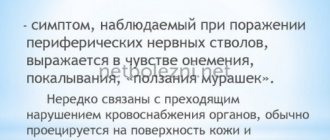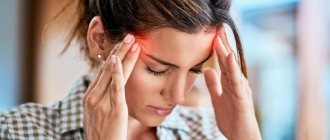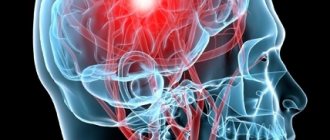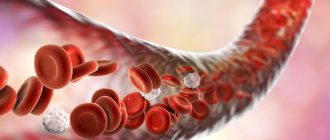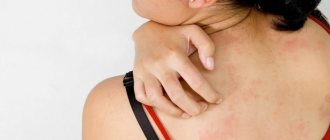Probable causes
Bumps occur anywhere in the human body and are often ignored until a certain point due to lack of time.
A lump that bothers you is the result of a person’s careless attitude towards their health. or small size.
The main complaint upon treatment is usually the word hurts, but it cannot become the basis for a reliable diagnosis.
It is necessary to undergo an examination and establish the real cause of the lump.
To determine the etiology, you need to find out the nature and intensity of the pain, conduct an external examination, and do laboratory tests.
The appearance of a lump may be due to:
- folliculitis (an inflammatory process that leads to the formation of an abscess, abscess or abscess);
- atheroma (which existed before, but now hurts due to the emerging purulent-inflammatory process);
- hemangioma (the cause of which is a pathological plexus of blood vessels and not only on the head);
- fibroma (a benign neoplasm, in some cases capable of transforming into malignant fibrosarcoma);
- lipoma (usually they are painless, and they hurt if they put pressure on blood vessels or nerve endings during the growth process);
- trichoepithelioma (benign neoplasm, sometimes inherited);
- wart (a characteristic sign of damage by the papilloma virus, dormant in the body, arising due to weakened immunity);
- enlarged lymph nodes caused by a general somatic disease of the body;
- osteoma (benign bone cyst).
A tumor (or lump) may also appear in the plural, in which case this is an even more alarming sign.
Small lumps are often the result of a bruise or injury. The bumps may be associated with insect bites.
Physiological seals are accompanied by other characteristic signs (nausea, dizziness, nausea and vomiting if there has been a traumatic brain injury), or they itch and hurt when pressed.
Causes
The reasons for the appearance of cones are varied, so they can be divided into several separate groups:
- bumps after injury. Impact or bruise of soft tissues is the most common factor in the development of a tumor. As a result, swelling forms, and the bruised area is very painful. As a rule, such bumps go away on their own without serious treatment. Cold compresses and applying heated cabbage leaves will help speed up the recovery process. Also in such a situation, iodine in the form of a grid is effective. Relevant for injuries to the forehead and back of the head. If tumors form, you should consult a doctor in order to exclude the possibility of traumatic brain injury;
- bump from a bite. Small swellings on the forehead, head, and body can occur as a result of an insect bite. This is an allergic reaction to the saliva secreted by the parasite. As a rule, you can see a small point on the surface through which the poison penetrates. The diameter of the affected tissue can reach 2-3 cm. Such bumps go away on their own or after using antihistamines. They are very itchy and have a dense consistency;
- lump in the form of a subcutaneous formation. Such tumors do not respond to standard treatment and slowly increase in size. Such growths include atheromas, lipomas, fibromas, hemangiomas, and warts.
Other possible causes of tumors on the head
If you feel a lump behind your ears or on the back of your neck, it could be an enlarged lymph node. Such bumps most often occur in young children, as the immune system adapts in the first months of life. Most often, such a lump grows during infectious diseases and decreased immunity. Such a formation must be shown to an immunologist; he will be able to determine what caused it and prescribe medications for treatment, if necessary.
If skin care is not taken care of, a sebaceous gland cyst may appear. With such a tumor, you must definitely visit a doctor, since you need to have surgery. Among the benign ones are:
- Lipoma is a tumor that is a clot of adipose tissue, or a wen. Rarely it can become malignant, turning into liposarcoma. It is treated on an outpatient basis, by removal under local anesthesia.
- Hemangioma - formed from blood vessels. Has a dark tint. Hemangioma most often appears due to heredity, progression of vascular disease, or exposure to ultraviolet radiation. Treatment methods: cryotherapy, injections, hormonal therapy, removal, radiation, cauterization, electrocoagulation.
- Fibroma is a tumor of connective tissue. Fibroids appear with excessive use of beta blockers, due to hereditary predisposition, diabetes, chronic diseases of the reproductive system, hormonal imbalance, parasites. The fibroid is removed if it causes discomfort and does not pose a threat to life. Treatment is carried out in the form of laser or radiation therapy, surgical removal.
Malignant tumors are like a ball under the skin. They have mobility and often uneven edges, are accompanied by pain and enlarged lymph nodes. Appear on the back of the head, neck and other parts of the head. Surgical treatment, radiation or chemotherapy are carried out.
Osteoma
If a bone lump appears on the back of the head, it may be osteoma.
With this disease, a bone tumor is formed, which is benign in nature. The formation of the cone is slow. The risk group mainly includes children (most often boys) over 4 years of age and young men under 21 years of age. In some cases, the development of the tumor is accompanied by pain. The tumor is spherical, with clear edges, hard, like bone. It occurs due to hereditary predisposition (more than half of cases) or as a result of injury, rheumatism, gout or syphilis. Osteoma does not go away without surgery.
Diagnosis of pathology
Birth injuries are not uncommon. The bones of the skull are subject to enormous stress as they pass through the birth canal. The newborn is carefully examined by a neonatologist, who diagnoses pathology if it is present. To clarify the diagnosis of cephalohematoma, ultrasound, head X-ray and other examinations are performed (we recommend reading:).
It is easiest to identify a hemangioma by its appearance and characteristic red color. In the future, the surgeon should monitor it, monitor its growth and dynamics.
If you find a ball-shaped lump on the back of a child’s head after a bruise, it is better to immediately show it to the doctor. The main criteria that the doctor focuses on during the examination:
- size;
- number of cones;
- location;
- color;
- amount of blood leaked (in case of injury);
- general condition of the patient.
By comparing all the parameters and assessing the possible risk of damage or danger to the brain, the doctor will make an accurate diagnosis. Only with light blows can you do it yourself.
Features of bumps on children's heads
In childhood, bumps on the back of the head in most cases are the result of injury. Even newborn babies are not immune from them - the soft tissues of the head are damaged during the process of passing through the birth canal. Typically, such bumps do not require special treatment, but it is better to consult a doctor.
Also, the appearance of swelling on the back of a child’s head may indicate inflammation and enlargement of the lymph nodes. Children are not immune from wen. They occur in childhood due to disruption of the sebaceous glands or ignorance of basic rules of personal hygiene. The likelihood of a malignant tumor or precancerous condition forming in a child is small, but it cannot be excluded.
What to do if a child has a lump on the back of his head?
- Causes
- Symptoms
- Treatment methods
A lump is a subcutaneous neoplasm related to a benign tumor. If the defect appears as a result of mechanical damage, then it is not a tumor, but a bulge consisting of lymph and blood.
Parents of active children often notice that their child develops bumps only on the head, and on an arm or leg, even with strong blows, only a bruise. The fact is that when damage occurs to the extremities, blood and intercellular fluid are quickly distributed in the subcutaneous fatty tissue.
There is no such layer on the head, so after damage to the blood vessels, the blood has nowhere to go except to be localized between the skull and skin in the form of a lump.
Causes
The tumor may feel soft or hard to the touch. After falling or hitting a sharp corner of furniture, hard swellings form. If the consistency is soft, a benign tumor (cyst) can be assumed. If the lump on the back of the child’s head was not caused by a blow, then it may be the following types of neoplasms:
- Lipoma;
- Fibroma;
- Wart;
- Atheroma;
- Osteoma;
- Furuncle;
- Hemangioma;
- pilar cyst;
- Cephalohematoma;
- Enlarged lymph nodes;
- Insect bite;
- Allergic reaction;
- Mechanical injury.
The name wen is also common among people. A neoplasm consisting of a sebaceous mass. Lipoma can be effectively treated with folk remedies. A paste of laundry soap and boiled onions is used. Fibroma looks like a dense ball on a stalk.
An excellent remedy for resolving fibroids consists of beet juice and golden mustache. In some cases, specialists prescribe removal. Warts are removed using modern hardware techniques using laser, electrical stimulation, and liquid nitrogen. A pilar cyst is formed as a result of a blockage of the sebaceous duct.
With prolonged accumulation of fat, a hard lump grows on the back of the child's head. Osteoma is a benign bone growth in the form of a lump on a baby's head. Characterized by regular shape, hard to the touch. The child does not complain of pain.
Cephalohematoma is a common tumor among newborns - this is a small tumor in which blood accumulates. The reason is the difficult birth process, in which doctors use forceps to wrap around the baby's head.
Note!
Hemangioma is a dangerous formation. It can degenerate into a malignant tumor. Upon careful examination, the hemangioma is visible through the vascular network. Surgeons remove the tumor and send the contents to a histology laboratory.
Symptoms
The tumor can form in any part of the head
Particular attention should be paid to swelling at the back of the neck. These neoplasms can lead to serious consequences
It is urgent to take the baby to the clinic. Associated symptoms include:
- nausea;
- vomit;
- strong pain;
- the baby is crying;
- convulsions are present;
- blood flows from the nose and ears;
- there are bruises, bruises, hematomas;
- the injured area is swollen.
The above symptoms indicate that there is a bump on the back of the child’s head after a fall, and a strong blow damaged the skull. As a result, the doctor diagnoses a traumatic brain injury. Concussions also happen. In which the patient also experiences severe nausea, vomiting, and dizziness.
Treatment methods
If a bump forms on the back of the child's head, the child often experiences bruising and bruising from the blow. With such damage, it is necessary to apply a cold compress to the sore spot as quickly as possible. To do this, use ice wrapped in a handkerchief.
The compress is held for about 10 - 15 seconds, then released for 5 - 10 seconds. The procedure is performed over 15 minutes. Such actions will prevent an increase in the hematoma and help reduce swelling. Alternatively, a towel soaked in very cold water or a strong saline solution is acceptable.
For a quick recovery, doctors recommend topical medications. Anti-inflammatory ointments with a resorption effect are used. Among folk methods, the following method is widespread. Twice a day, the lump is wiped with an alcohol solution, and then an iodine mesh is applied.
If you find a lump on the back of the head or forehead of your baby, you need to visit different specialists: a surgeon, a neurosurgeon, an otolaryngologist, an allergist, an oncologist. A conscientious attitude to the treatment of a child and a timely visit to the hospital will allow the pathology to be diagnosed at an early stage and dangerous consequences to be prevented.
Loading…
Oily seborrhea
If too much sebum is produced, this can also lead to dandruff. The fact is that the secretion does not contain enough antibacterial substances. Favorable conditions are created for an increase in fungal colonies. The active activity of Malassezia leads to detachment of the epidermis and the appearance of oily dandruff.
Symptoms of oily seborrhea:
- greasy hair;
- itching;
- The scales stick together and peel off very poorly.
Oily seborrhea is often accompanied by acne and furunculosis. The skin of the scalp becomes crusty; scratching during itching leads to bloody wounds. If adequate treatment is not carried out, hair will begin to fall out.
Seborrhea, associated with increased sebum production, occurs not only on the scalp. It also appears on the face, especially in the area of the nasolabial triangle, behind the ears and on the chin. On the face, the disease is characterized by enlarged pores and graying of the skin.
The most common cause of oily seborrhea is hormonal imbalances. The disease often plagues adolescents during puberty. Most often, young men suffer, because it is male hormones that provoke the activity of the sebaceous glands.
Normally, seborrhea is temporary; by the age of 25, it goes away in most people. In 10% of cases the disease becomes chronic.
Another common cause of oily seborrhea is genetics.
Also, the impetus for the disease can be:
- frequent stress;
- deviations in the functioning of the nervous system;
- taking hormones;
- problems with the gastrointestinal tract;
- diseases of the genitourinary system.
Reasons for appearance
There are many reasons why tumors may appear:
- Injuries and bruises. The most common problem after which bulges appear on the head. In this case, a small painful swelling appears, which looks like a growth from the outside.
- Allergic reaction to an insect bite. Depending on the degree of reaction to an insect bite, the neoplasm can be from 5 mm to several centimeters in diameter, accompanied by itching and unpleasant but tolerable sensations. To relieve itching and redness, you will need to use antiallergic medications; you should consult a specialist.
- Inflammation of soft tissues:
- Furuncle (purulent neoplasm, appears from a staphylococcal infection).
- Abscess (subcutaneous accumulation of pus, appears due to a focal bacterial infection).
- Enlarged lymph nodes (inflamed when adenoviral infections penetrate the body).
- Subcutaneous formations:
- Atheroma (cyst). Formed due to blockage of the sebaceous gland, it is painless and can reach the size of a fist. When infected and suppurated, it is accompanied by a feeling of pulsation at the site of the tumor and an increase in temperature.
- Lipoma (fat). Appears due to excess fat deposition in the skin, consists of fat cells and does not cause pain.
- Wart. Caused by the human papillomavirus, it usually appears on the head due to weakened immunity.
- Fibroma, sarcofibroma. Fibroma is hard to the touch and is itself a benign tumor. Sarcofibroma is malignant.
- Osteoma (benign tumor formed from bone tissue).
Warts
They can be located in the form of bumps on the forehead above the eyebrows and not only, causing unpleasant sensations to the person. However, they do not cause any pain. Quite a lot of warts form over a person’s entire life, and they do not have to be removed.
The exception is the occurrence of various infections. The reason why warts appear is infection with the human papillomavirus. They are capable of growing and reaching a size of 0.5 cm. For warts on the head under the hair, treatment will consist of several stages, the implementation of which guarantees getting rid of the bumps on the head.
First, a sick person should consult a dermatologist, who will prescribe a histological examination, as well as dermatoscopy. Then a medicinal course of treatment will be prescribed, including antiviral drugs of general and local action. In some cases, laser wart removal is used.
Types of tumors on the head and their signs
Hemangioma
A large growth on the head that occurs when the circulatory system is disrupted. The veins can grow uncontrollably, resulting in a red lump. Under the tubercle you can see a network of blood vessels. Doctors consider hemangioma the most dangerous type of tumor.
It is the hemangioma that leads to disruption and formation of the surrounding tissues of the head. Often this type of tumor is located under the hair. A small hemangioma can grow in size over time and become a malignant tumor. If a hemangioma emerges, you must seek specialized medical help.
Allergic reaction
A bump on the head occurs when the human body is exposed to certain allergens. An allergic reaction is caused by food, household chemicals or cosmetics. Such bumps itch and bring a lot of unpleasant sensations to a person. To avoid the formation of such bumps, you should optimize your diet and buy products only from trusted manufacturers.
Fibroma and sarcofibroma
Fibroma is a benign tumor. It consists of connective tissues of the scalp. Fibroids appear on the back of the head, forehead and other parts of the body. In an adult, the tumor can reach significant sizes. The main factors that provoke the occurrence of fibroids: heredity, diabetes or hormonal imbalance. Fibrosarcoma has similar causes, but is a malignant tumor. If left untreated, it leads to death. Most often, fibroma is hard to the touch and does not cause pain to a person.
Lipoma on the head
Lipomas form on damaged human fatty tissues. These are benign tumors. Women over 30 years of age are susceptible to developing growths. Frequent changes in hormonal levels and impaired fat metabolism lead to the formation of lipomas. Such tumors develop both on the head and on other parts of the body. The lipoma is round in shape and soft to the touch. It can be detected in the hair on the back of the head.
Pimples and bites
A person can detect the presence of a lump if it is bothersome and itchy. It could be a bite or acne. Occurs due to poor hygiene or inflammation of the scalp. It does not require specialized medical treatment and goes away on its own within a few days. To speed up healing, you can use compresses or creams.
Bruise or injury
The human body is often susceptible to various types of bruises. And the head is no exception. With a severe bruise, a tubercle forms, which is very painful when touched. This lump is distinguished by its red color and swelling. Heals on average within a few days. If the headache does not go away, you should visit a specialist. This will help rule out traumatic brain injuries.
A wart is a benign tumor that reaches a significant size. This brings a person a lot of unpleasant sensations, in particular due to appearance. The main factors that provoke the development of warts: hormonal imbalance, inflammation and mechanical damage. Warts, in addition to their slow growth, are capable of multiplying and occupying a significant part of the skin. The cone itself resembles a small brown ball. It's not painful. The wart is constantly growing and reaches 0.5 cm in diameter.
Atheroma on the head
Atheroma is growths on the skin. They occur at any age. Both men and women suffer from this disease. It occurs due to blockage and obstruction of the sebaceous glands on the head. Atheroma has a convex and smooth surface, most often yellow. If atheromas are not removed, they hurt and cause discomfort. Lipoma and atheroma are very similar in appearance, so only a doctor can make an accurate diagnosis after diagnosis.
Wen on the head
A lump on the head is a hard, round tumor. Wen forms over the human skin. Fatty spots occur due to hormonal imbalances and frequent stressful situations. They usually have a non-infectious etiology. If the wen interferes with a comfortable life (clings to clothing), it is removed. Removal takes place in a hospital under the supervision of a doctor.
Childhood is a wonderful time, you can play and fool around, ride a bike and climb trees. Of course, most fun games don't come without bruises, scrapes and bumps. What to do if a child falls and hits his head? Or you found a bump on the head, but the baby did not fall. Should I worry and when should I consult a doctor?
Warts
These are benign formations on the skin, consisting of connective tissue and covered with epithelium. Warts appear on any part of a person’s skin, including on the head. Doctors distinguish several types of wart bumps in humans: regular, flat, plantar, senile and pointed. The cause of warts in humans is infection with the papilloma virus, which can be transmitted through household contact, as well as through contact with an infected person. After infection and the first appearance of a wart bump on the skin, a long time may pass. If one wart appears on the skin, then in this case the patient should be very careful with it so as not to damage it, otherwise this virus can be spread throughout the body. There are many different methods for treating warts with folk remedies, using compresses, ointments and various tinctures, however, before using them, you must first consult with a specialist, as this can significantly harm your body. Traditional medicine to remove a bump on the head involves the use of methods such as surgery, radio wave therapy or laser removal. The doctor himself determines which method to choose.
When a bump appears on your head, you should not despair, especially since it is not painful. And the first thing to do is visit the doctor's office in order to rule out serious diseases and, if necessary, receive appropriate treatment.
A bump on the head may be the result of a blow. It usually doesn’t hurt and doesn’t cause much discomfort. However, its appearance is not always so harmless. If the lump is suspicious, very painful, swollen, and even the temperature has risen, and is localized on the back of the head or on the sides of the skull, then it is still worth identifying the cause of its appearance. A lump may appear as a symptom of a neoplasm or other pathology in the body that requires diagnosis and treatment, possibly even surgery.
A bump on the head can appear as a result of external trauma: from a bruise or an insect bite, or internal: from a lipoma in the form of a wen, osteoma, furunculosis, kateroma (cyst formation), trichoepithelioma, enlarged lymph nodes.
- Injury. The lump appears on the head in the form of a hematoma with an accumulation of blood under the skin, hurts on palpation, and takes on a lilac or eggplant hue. It is necessary to treat, open surgically, clean the wound from accumulated blood and possibly pus.
- Mosquito, bee or wasp bite. Swelling on the head, burning sensation, pain, itching, and fever may occur. Treatment consists of treating the affected areas, washing with antiseptics, and applying antiallergic ointments (gels). You can't scratch the bump. It is better to immediately go to the emergency room for help, especially if the temperature rises and severe itching overcomes.
- Atheroma in the form of a neoplasm localized on the head due to insufficient outflow of the secretion of the sebaceous glands, their blockage, and the accumulation of a dense consistency under the skin. Requires surgical removal and examination of the material for histology. Usually this is a benign cyst of origin.
- Lipoma in the form of a wen, a benign tumor of dense consistency. Usually the lump does not hurt and does not cause much discomfort. Localizes the forehead and scalp. Appears as a result of metabolic failure and pathology of adipose tissue. It is hereditary in origin and can degenerate into liposarcoma, a malignant neoplasm that requires removal by laser, cryodestruction or surgery.
- Trichoepithelioma is a benign tumor on the head that is usually hereditary. It can be grouped in the form of dome-shaped numerous small elements on the head up to 6 mm in diameter, growing over time, usually not painful on palpation. Treatment involves surgery or electrocoagulation.
- Osteoma in the form of a benign cyst with slow growth, but not capable of degenerating into a malignant form, metastasizing, or growing into nearby tissues. The lump hurts, but sometimes it is not felt at all. Smooth to the touch, slightly raised above the bone tissue in the shape of a ball with smooth edges. The cause of the appearance may be heredity, injury, a number of diseases: gout, rheumatism, syphilis. It must be removed by cutting off nearby healthy areas of bone tissue.
Causes of skin diseases
Scalp diseases can be caused by the following:
- weakened immune system;
- nervous overstrain, mental illness;
- metabolic disorders in the body;
- lack of personal hygiene;
- infectious diseases;
- unbalanced diet, lack of vitamins;
- incorrectly selected shampoos and conditioners;
- fungal diseases of the scalp;
- allergy;
- hereditary diseases;
- disturbed ecology;
- abuse of chemicals;
- damage to the scalp as a result of bruises, as well as from iron hairpins.
Expert opinion Zemlyanukhina Tatyana Vyacheslavovna Ambulance and emergency medical assistant at the Emergency Clinical Hospital #7 in Volgograd.
Ask an expert
Particular attention should be paid to mycoses. Since fungal diseases are very common on human hair, especially on the head, where there is most hair
You can easily catch a fungal infection just by leaning on the headrest in a taxi. The fungus is often disguised as ordinary dandruff and you may not know about its presence for many years. At the first problem with your scalp, be sure to contact a specialist.
Diagnosis of the disease
Often, the clinical picture alone is sufficient to make a diagnosis and determine a treatment regimen. In some cases, the use of additional diagnostic techniques is still required. In particular, they are necessary to clarify the nature of the tumor and exclude its malignant nature.
To determine the nature of the lump, you may need to undergo the following procedures:
- general blood and urine tests - aimed at identifying an infectious or inflammatory process;
- blood biochemistry - allows you to identify problems with metabolism and suspect oncology;
- the use of tumor markers is an informative method for detecting cancer;
- X-ray or CT scan of the skull - help assess the condition of the bones of the skull, exclude their fractures, the presence of cracks;
- Ultrasound – aimed at studying the structure of the lump, its composition and the depth of penetration into the tissue;
- histology – studies the cellular structure of the biomaterial, which allows you to quickly make a diagnosis;
- A biopsy is another way to examine tissue for cancer.
Based on the diagnostic results, the optimal treatment method is selected. If necessary, the procedures are repeated several times, which makes it possible to evaluate the effectiveness of the treatment.
What is herpes on the scalp?
We recommend reading: Ollin hair dye: review, color palette
This is a fairly common disease that spreads throughout the scalp and has accompanying symptoms:
- ENT diseases.
- Manifestation of inflammation of the lymph nodes on the head and neck.
- Severe rash and itching in the scalp.
- Increase in body temperature to 39 degrees.
- The patient begins to feel sick, vomiting, and loss of appetite.
- There is severe pain in the head.
- There is a loss of strength, the person feels weak.
Many people know that herpes is a viral disease that is quite easily transmitted from person to person. But it is necessary to understand the fact that such a disease develops gradually; it has 4 main stages:
- Initially, a person feels a not entirely pleasant sensation in the place where the herpes will appear. Depending on the individual characteristics of the body, this may be redness, pain, tingling or itching.
- Now there is active inflammation of the scalp. As a result, you can observe painful light blisters, inside of which there is a clear liquid.
- When these bubbles mature, they begin to burst, causing the liquid to flow out. This is a very dangerous time, because in addition to unpleasant sensations, there is a high probability of harmful bacteria and microbes getting into open wounds. Here there will be not only a deterioration in the patient’s condition, but also infection of those people who are around him.
- As a result, a scab appears in the places where the bubbles exploded.
As for the impact of such a disease on the body of an adult, it will be treated only with the use of special medication. As a result, the scab will be able to dry out, its remnants will go away, and the scalp will be renewed. The condition will be worse if the person who has received this disease drinks a lot of alcohol, smokes, or has other bad habits. Those people who have a severely weakened immune system cannot do without thorough treatment, because their disease will be much more difficult to treat.
How to get rid of acne on your head
- You can get rid of acne on your head through treatment. To do this, you need to consult a trichologist, who, after diagnosis, will prescribe a treatment that is suitable for you.
- Pimples can disappear if the underlying disease causing their appearance is eliminated: for example, stomach problems, etc.
- Folk remedies: solarium (dries out the skin, reduces the production of sebaceous glands); homemade hair masks and shampoos.
Traditional recipes for getting rid of acne on the head
This problem needs to be approached comprehensively. In addition to the individually selected medications that your doctor will prescribe for you, based on the test results, you should also turn to traditional medicine. These recipes have been collected by our grandmothers for many years. They relieve itching well and eliminate purulent inflammation.
It has antiseptic properties. This product should be used no more than 4 times a month. We buy colorless henna for hair in a specialized store and pour it into a shallow bowl. Fill with one glass of hot water, it should be no more than 70 degrees. Let it sit for several hours. Then add one chicken egg and mix well until smooth. Apply the product to the scalp and leave the product on for about 30 minutes. Next, rinse your hair and head well, you can use shampoo.
Tincture of calendula
This product can be easily purchased at any pharmacy, and it is inexpensive. It has the ability to normalize the functioning of the sebaceous glands. To prepare the solution, take 2 tbsp. tinctures and mix with 250 grams of water, blot a cotton pad and wipe the scalp 2 times a week.
Tea tree oil
Has antibacterial and antiseptic properties. To solve such an unpleasant problem as acne, you just need to add a couple of drops of this product to your shampoo.
Aloe juice
This remedy has anti-inflammatory, antibacterial and wound-healing properties. We cut off the lower and thick leaves of this plant. They contain a large amount of juice. Squeeze the juice out of them and apply to the scalp. After this, you need to put on a hat and wrap your head in a towel. After half an hour you can wash it off.
Apple vinegar
The solution should be diluted in advance: 100 ml of vinegar per 100 ml of water. First, wash your hair with shampoo and then rinse with the prepared product. After 5 minutes, rinse your hair well with water without using shampoo. This will avoid an unpleasant odor.
This soap can be found at a pharmacy or in the hardware department of any supermarket. It is also available in liquid form, but this product costs much more (about 150 rubles).
Honey and cinnamon mask
Preparing such a remedy will not be difficult. Take 2 tbsp. honey and 1 tsp. cinnamon, mix well. Apply the resulting product to problem areas or the entire head. You can wash off the mask after 30 minutes.
Strawberry juice
Only freshly squeezed juice is suitable. It cleanses the scalp well. This juice destroys many pathogenic bacteria and also heals wounds. It contains a large number of vitamins and microelements. Periodically you need to lubricate the affected areas of the head.
Anise
Perhaps the most valuable part is the seeds. They contain a large amount of vitamins and minerals. This plant has analgesic, antiseptic and anti-inflammatory properties. Anise fruits can be purchased at the pharmacy. They should be filled with warm water and left to swell overnight. In the morning, grind the seeds into a paste. We apply it to the affected areas of the scalp. Leave it on for about an hour and then wash it off. This mask can be done 3 times a week.
Salt baths
There is one BUT in this method! If previously such a composition contained only natural ingredients, now it contains many artificial additives, so it can be used for no more than 2 weeks. We purchase a special composition and take a bath with it every day.
As you can see, there are a lot of folk and cosmic remedies for combating rashes, but the main task is to identify the cause of their appearance. In the presence of gastrointestinal diseases, folk remedies and space remedies will not be effective.
Useful video about the beginning of a baby's life
A baby's lump on the back of the head can be hereditary and appears right from birth, or maybe a little later. According to the teachings of the occult sciences, such a phenomenon indicates cosmic magnetism. A pronounced lump indicates that its owner is capable of greatly influencing others. And the dent indicates a break in the harmonious connection with the world. A lump on the border between the crown and the parietal part indicates the greed of its owner. Is it necessary to get rid of such signs?
Causes
A lump in a child on the back of the head, as a rule, appears due to mechanical impact. In ancient times, such damage was removed using a cold penny, which was applied to the sore spot. Today this practice does not bring results. Previously, the coin was heavier and the metal was more noble. But don't despair. Today there are other ways to get rid of such injuries.
How to get rid of such a problem?
Every home is sure to have iodine, alcohol, salt, oil, egg and thyme. If the bruise is very painful, you need to apply cold to it. Take a piece of meat out of the freezer, wrap it in a cloth and apply it to the sore spot. Don't forget to turn the piece over periodically. Soon you will feel that the pain is receding, and after a while the hematoma will become less large. After a day, you can use a warm compress. It will perfectly relieve swelling. Simply heat salt or an egg or use Thyme Leaves will help with healing. Make a decoction of them and wet your head with it.
We use drugs
If the child does not go away, take “Troxevasin” ointment, which has a resolving effect, or “Rescuer” gel. Treat the hematoma with one of the remedies, and the headache will immediately stop hurting, and after some time everything will go away. However, the child may well have a lipoma. This is what is formed from adipose tissue. Such lumps are usually painless, but their size can put pressure on nerve endings and surrounding tissues. She's not going anywhere on her own. It must be removed. Perhaps this will be done using radio waves (if the lipomas are small). It happens quickly, painlessly and heals soon.
Folk remedies
The cone of Siberian healers is called shishun. They claim that the best remedies for their deliverance are prayer and onions. To do this, you need to take a small onion, bake it in the oven, grind it well and mix thoroughly with one-third of a piece of laundry soap until the mixture becomes homogeneous. Such a compress should be applied to the sore spot and changed three times until the lump on the back of the child’s head softens. At the end of the procedure, an unpleasant odor liquid should pour out. To prevent such shishuns from appearing again, you need to read the conspiracy after sunset on the outgoing moon. Siberian healers also advise adhering to certain postulates so that a bump does not appear on the back of a child’s head. There is no need to scratch your head with your left hand while eating. Avoid cutting your hair during the holidays and twirling your hair. Following such recommendations will not make the child worse. But in any case, you need to visit a doctor and make sure there are no serious diseases.
Treatment
Treatment for the resulting lumps depends on the type and cause.
First aid for injury is to apply a cold compress to the injury site (frozen foods are often used for this). Keep for about 10 minutes. Preparations in the form of ointments and gels are also used:
- Troxevasin – strengthens vascular walls, relieves swelling. Rub in gently twice a day.
- Troxerutin - effectively eliminates swelling; it is forbidden to apply to injuries where the integrity of the skin is compromised.
- Heparin ointment - relieves pain and resolves blood clots.
- Rescuer - antiseptic effect.
If insect bites occur, treat with soap and cold; if symptoms persist, use anti-allergenic agents. If necessary, consult an allergist or dermatologist.
For lipoma, self-treatment is not carried out; the help of a surgeon is required. Most often it is removed surgically, with a laser, or using a special substance that resolves fat (injected into the wen itself).
For atheroma, the use of various ointments and folk remedies turns out to be ineffective; they are best used for faster healing after removal or self-opening of the tumor. Removal of atheroma is carried out surgically, laser and radio wave methods.
On this topic
Treatment for fibroids is primarily aimed at eliminating the cause. Next, the tumor is removed using a laser, surgery, cryodestruction (using low temperatures) or radio wave method.
There are several ways to remove a hemangioma:
- Application of liquid nitrogen (no traces are left).
- Microwave cryodestruction – for deep facial tumor localization.
- Radiation therapy – for damage near the eye.
Therapy is carried out exclusively under the supervision of a doctor, since the risk of transformation into a malignant tumor is high.
The boil is removed by a surgeon on an outpatient basis, after which antibacterial and physical therapy is prescribed.
The most effective way to remove a wart is to remove:
- Current therapy is not the most effective method; several sessions are often necessary.
- Freezing with nitrogen is expensive and the surgery leaves visible scars. Long-term postoperative care is also necessary.
- Laser burning is the most widely used procedure and is carried out quickly. No traces remain and similar neoplasms no longer appear.
- Surgical intervention.
Lump on the forehead of a baby
The main cause of bumps on the forehead of a baby are mechanical injuries, blows and falls. The formation of a large lump after an impact is normal. Such tumors in most cases do not require seeking specialized medical care. They represent swelling of the soft tissues as a result of a bruise, filling them with blood from damaged vessels and subsequent hematoma rising above the surface of the skin. The bumps on the forehead are the largest, because this is where a large number of small vessels pass. At the same time, this part of the head is more durable compared to the temple or back of the head.
What to do if you have a lump on your child’s forehead
First of all, immediately after a blow or bruise, cold should be applied to the damaged area or lubricated with a special ointment. The hematoma usually resolves completely within three weeks. If this does not happen, then you should seek medical help, as in this case a puncture and removal of the contents may be necessary. In addition, a child who has received a blow to the head for any reason must be carefully observed, noting any unusual moments. With symptoms such as a noticeable decrease in reaction, lethargy, lack of reaction to light and different pupil sizes, sweating, drowsiness, constant moodiness, confusion, you need to consult a doctor. Even more dangerous signs are convulsions, vomiting, loss of consciousness, speech impairment - all this is a reason to immediately call an ambulance, because these symptoms indicate a concussion. In cases of severe injury and a large lump, an x-ray may be taken to ensure there are no cracks in the skull.
Other reasons for the appearance of bumps on the forehead of a baby
Lumps on a child’s forehead may be an individual anatomical feature of the structure of a particular child’s skull. In this case, they are not dangerous and do not require any treatment. Most often, over time, the bump on the forehead smooths out and becomes less noticeable.
There are other types of bumps in infants that can appear on the forehead. These formations include benign tumors, characterized by an unchanged structure and gradual growth. One of the varieties of such tumors is wen (lipoma and atheroma). They can occur on any part of the body, the reason for their appearance is clogging of the sebaceous glands. The distinctive features of these two types of neoplasms are the growth rate, as well as the fact that atheroma suppurates and becomes inflamed much more often. Both of these tumors are treated with surgery.
Another type of benign tumor that occurs on different parts of the body is fibroma. It can reach quite large sizes. The reasons for its appearance are still unknown. This lump does not cause significant harm to health, so if it is small in size, does not grow and does not interfere with normal life, it does not need to be removed. Otherwise, surgery is necessary.
